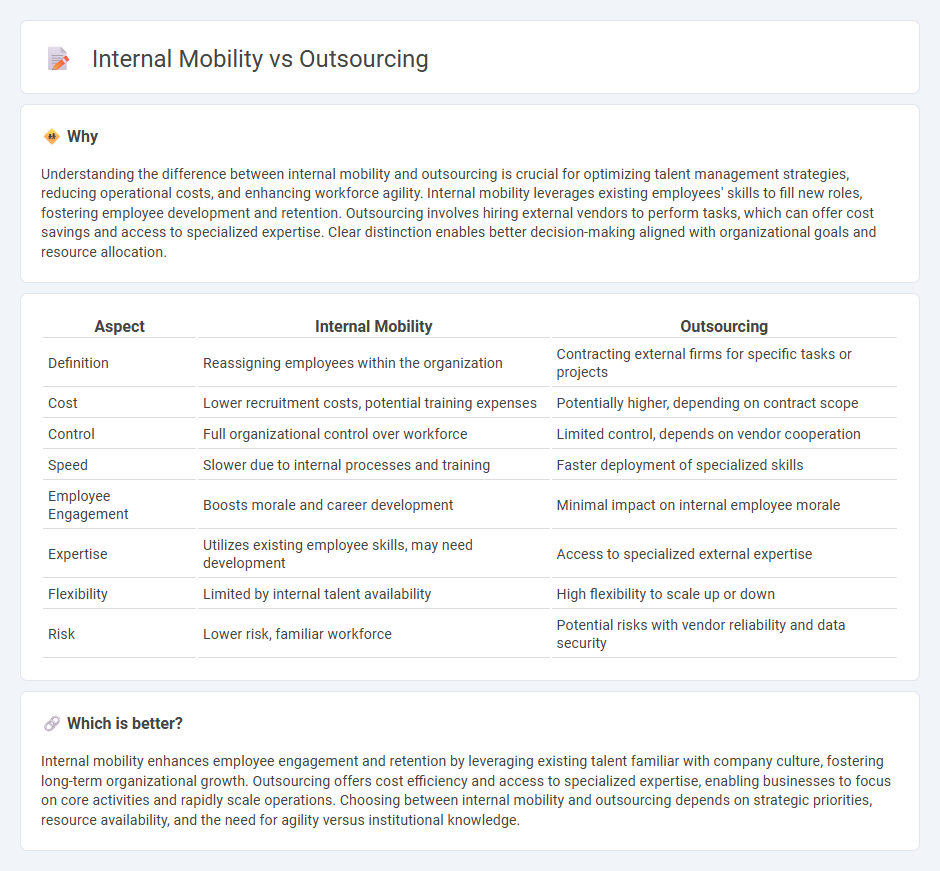
Internal mobility enhances employee retention by leveraging existing talent and fostering career growth within the organization, resulting in reduced recruitment costs and improved cultural alignment. Outsourcing offers access to specialized skills, scalability, and cost efficiency by delegating non-core functions to external providers. Explore further to understand how balancing internal mobility and outsourcing can optimize workforce management strategies.
Why it is important
Understanding the difference between internal mobility and outsourcing is crucial for optimizing talent management strategies, reducing operational costs, and enhancing workforce agility. Internal mobility leverages existing employees' skills to fill new roles, fostering employee development and retention. Outsourcing involves hiring external vendors to perform tasks, which can offer cost savings and access to specialized expertise. Clear distinction enables better decision-making aligned with organizational goals and resource allocation.
Comparison Table
| Aspect | Internal Mobility | Outsourcing |
|---|---|---|
| Definition | Reassigning employees within the organization | Contracting external firms for specific tasks or projects |
| Cost | Lower recruitment costs, potential training expenses | Potentially higher, depending on contract scope |
| Control | Full organizational control over workforce | Limited control, depends on vendor cooperation |
| Speed | Slower due to internal processes and training | Faster deployment of specialized skills |
| Employee Engagement | Boosts morale and career development | Minimal impact on internal employee morale |
| Expertise | Utilizes existing employee skills, may need development | Access to specialized external expertise |
| Flexibility | Limited by internal talent availability | High flexibility to scale up or down |
| Risk | Lower risk, familiar workforce | Potential risks with vendor reliability and data security |
Which is better?
Internal mobility enhances employee engagement and retention by leveraging existing talent familiar with company culture, fostering long-term organizational growth. Outsourcing offers cost efficiency and access to specialized expertise, enabling businesses to focus on core activities and rapidly scale operations. Choosing between internal mobility and outsourcing depends on strategic priorities, resource availability, and the need for agility versus institutional knowledge.
Connection
Internal mobility enhances organizational agility by leveraging existing talent, reducing recruitment costs, and improving employee retention, while outsourcing complements this by filling specialized skill gaps and managing workload fluctuations efficiently. Both strategies optimize resource allocation and drive operational flexibility, enabling companies to respond swiftly to market demands and maintain competitive advantage. Integrating internal mobility with outsourcing initiatives streamlines workforce management and supports strategic growth objectives.
Key Terms
Cost Efficiency
Outsourcing often reduces labor costs by leveraging economies of scale and accessing specialized skills at lower market rates, while internal mobility minimizes recruitment expenses and enhances employee retention by promoting from within. Companies focusing on cost efficiency weigh the immediate savings of outsourcing against the long-term benefits of developing internal talent pools. Explore our detailed analysis to understand which strategy best aligns with your financial goals.
Talent Development
Outsourcing leverages external expertise to quickly scale talent resources, often providing specialized skills not available internally, while internal mobility emphasizes nurturing existing employees' growth through targeted development programs and career pathing. Investing in internal mobility enhances employee engagement, reduces turnover costs, and fosters a resilient organizational culture, critical for sustainable talent development. Explore strategies to balance outsourcing and internal mobility for optimal talent growth and business success.
Organizational Flexibility
Outsourcing enhances organizational flexibility by enabling companies to quickly scale resources and adapt to market fluctuations without long-term commitments. Internal mobility leverages existing talent, fostering agility through skill diversification and employee retention, which strengthens institutional knowledge and culture. Explore how balancing outsourcing and internal mobility can optimize your organization's adaptive capacity.
Source and External Links
What Is Outsourcing? (Including Types and Advantages) - This article explains the definition and types of outsourcing, highlighting its benefits for businesses, such as reducing costs and improving efficiency.
What is Outsourcing and How Does it Work? - This page provides an overview of outsourcing as a business practice where companies hire third parties to perform tasks or services, often including IT and customer support.
What is Outsourcing? Definition, Advantages, and Examples - This article defines outsourcing as contracting with a third-party service provider to perform specific tasks, highlighting its advantages such as cost savings and improved performance.
 dowidth.com
dowidth.com